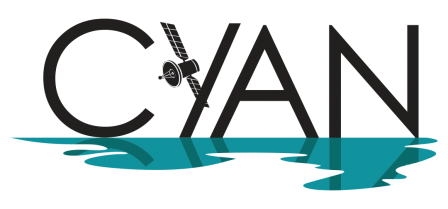Cyanobacterial Harmful Algal Blooms Forecasting Research
New Dashboard for Forecasts
Weekly forecasts previously posted on this webpage have resumed for 2025 and are now housed on EPA’s Harmful Algal Bloom Forecasting webpage.
Most species of algae are not harmful, but when certain types grow rapidly, they can cause harm to human and pet health, aquatic ecosystems, and local economies. Referred to as harmful algal blooms (HABs), this excessive growth is usually associated with algae that can produce toxins.
Even though they are classified as bacteria, cyanobacteria exhibit characteristics of algae and sometimes referred to as blue-green algae. Cyanobacterial HABs (cyanoHABs), can appear in water bodies across the country, are an indicator of poor water quality, and can potentially cause serious environmental concerns, including human and aquatic health effects. When harmful blooms occur in recreational waters or source waters used for drinking, the toxins released can cause respiratory or skin irritation and even illness in humans, domestic animals, and wildlife.
EPA researchers are working on ways to forecast when and where cyanoHABs may form. In 2024, EPA developed a cyanoHAB forecasting model for the population of lakes for which EPA provides near-real time satellite-based monitoring data through the multi-agency Cyanobacteria Assessment Network (CyAN) project. This new forecast model now provides a 7-day prediction of the probability of a cyanoHAB in these lakes.
Interpreting the Data
In accordance with the goals of the CyAN project, the forecasts described are from an experimental cyanoHAB forecasting model launched in 2024. This forecasting model was trained and validated with the CyAN satellite data but may contain errors and will be continuously improved over time. The focus of this forecast model is to provide weekly probabilities of cyanoHAB occurrences in 2,192 lakes in the contiguous United States that are resolvable by the Sentinel-3 satellite. A bloom is defined as median lake chlorophyll a ≥12 ug/L with cyanobacteria dominance. The weekly bloom probability forecasts have been produced following the workflow described in detail in Schaeffer et al. 2024.
What does a “weekly" forecast mean exactly?
The forecast model is structured to generate weekly cyanoHABs probabilities that are valid for a seven-day period extending Sunday through Saturday. For example, if forecasts are generated on a Sunday, they will be valid (i.e., representing the probability of a bloom occurring) through Saturday. However, if forecasts are generated a day later, on Monday, they will still only be valid through Saturday. Currently, beta test forecasts require about a day to generate, so it is likely they will be made available on Tuesday or Wednesday each week and will be valid for the remainder of the current week through Saturday.
How do we interpret the bloom probability and what part of the lake does the probability apply to?
The weekly forecasted bloom probability for each lake is the probability that the median lake chlorophyll-a in the surface (typically upper two meters or less) is ≥12 micrograms per liter (ug/L) across the lake area represented by resolvable/unmasked satellite pixels. The Sentinel-3 satellite imagery is divided into a grid of 300 × 300 meter pixels, each of which has a chlorophyll-a (with cyanobacteria dominance) concentration* associated with it.
During preprocessing of the satellite imagery, pixels that included cloud, cloud shadow, glint, straylight, snow, ice, or land cover were removed. From the retained pixels, a median chlorophyll-a concentration is calculated for each lake and is compared to the a threshold of 12 ug/L. Thus, when applying the forecast model, the weekly forecasted bloom probability for each lake is the probability that the median lake chlorophyll-a is ≥12 ug/L at the surface across the lake area represented by resolvable/unmasked pixels. The higher the probability, the higher the likelihood of a cyanoHAB.
No forecast is perfect, and most forecast models will result in false positives and negatives. This model should not replace regular sampling or observation methods. Currently, the model overpredicts positive events, where additional complementary field sampling or additional remote sensing may be useful. The model has low false omission and is therefore more conservative in protecting health.
For more information on how the data is calculated, please visit NASA's webpage on CyAN.
Why is my lake not included in this dataset?
Currently, the model can only generate cyanoHAB forecasts for the 2,192 lakes that are satellite- resolvable. Whether or not a lake is satellite-resolvable depends on the spatial resolution of the satellite imagery and the size of the lake. The spatial resolution of the Sentinel-3 satellite images used to train the forecast model is 300 × 300 meters, so the forecast model can only make forecasts for larger lakes. The feasibility of using higher resolution satellite imagery to forecast for a broader set of lakes is being evaluated.
Forecast Data
Weekly U.S. forecasts are posted to EPA’s HAB Forecasts page. Forecasting data are typically generated from the beginning of April through November as the probabilities of harmful algal blooms are generally lower during colder months.

